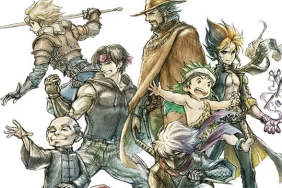The release of SaGa Frontier Remastered is a pleasant surprise. Upon its original release in March 1998, many players in the US didn’t know what to make of it. Its Free Scenario System combined pseudo-open world gameplay with JRPG standards to make a title that was ahead of its time in many ways. In retrospect, SaGa Frontier brought more innovation than it was given credit for, and it’s great to get a chance to play it in this enhanced form.
This remaster is a bit more than standard fair. In addition to having its backgrounds upscaled and sprites redrawn, it contains content that the devs had to cut from the original release due to lack of time. This includes an eighth scenario and some additional cutscenes to clarify a character’s story. This makes it more of a director’s cut than a straight remaster, though there is the option to play the game as initially released with the new content turned off.
More open-world than it seems
For those that aren’t familiar with the game, SaGa Frontier’s “Free Scenario System” has the game playing out in an almost open-world fashion. You pick between seven characters (with the eighth, Fuse, opening up after completing the rest), and once you complete one of their stories, you move on to the next. Each character has a different starting point, story, and characters that can be recruited. However, the action all takes place in an interconnected world which you’re (largely) free to explore.
Typically, each character has a brief introductory story segment, and once completed, you’re left to your own devices. Unlike SaGa Frontier’s contemporary, Final Fantasy 7, there’s often very little guidance on what your objective is outside of the obvious.
Sometimes the game will tell you very explicitly where to go, but not make it clear that a particular character needs to be in your party when you get there. At other times, you’ll be given a goal with no clear way to complete it. Also, though the enemies scale to your current power somewhat, you’re definitely expected to grind a bit. Don’t be surprised when you arrive at a destination only to get stomped due to a difficulty spike you couldn’t have foreseen.
Avoiding frustration
The addition of a Story Chart, which tracks your progress (to a degree) does help alleviate some frustration with finding the next step on your journey. However, because this game can be incredibly obtuse at times, even this new feature doesn’t help as much as you’d think it would. Some players will simply lose patience, and I can’t really blame them because it’s a game that makes you think about progression in a linear fashion while being wholly unlinear.
SaGa Frontier is more Elder Scrolls than Final Fantasy. You’re not meant to beeline directly from objective to objective. Despite the game never makes this clear, you’re expected to explore the various worlds, make allies, fight battles, do side quests, and stumble around until you finally make it back on the main story path. Each character has different events, side quests, and recruitable party members, so you’re meant to drink in each location and not just head from point A to point B.
SaGa Frontier Remastered Review: The Final Verdict
When you take the time to explore, you’ll find a surreal, beautiful game waiting for you. But, again, SaGa Frontier does an absolutely terrible job of making this clear. Fortunately, SaGa Frontier Remastered takes much of the frustration out of this. You can save anywhere, and there’s an autosave, you can speed up movement in the overworld and battles too. This is the best way to experience an often overlooked masterpiece, and I hope that SaGa Frontier 2 gets a similar treatment in the future.
-
New scenario and added cutscenes.
-
Remastered graphics are sharp without changing the aesthetic.
-
Plenty of Quality of Life upgrades.
-
Still an enthralling RPG with a beautiful, surreal universe.
-
Still incredibly obtuse.













